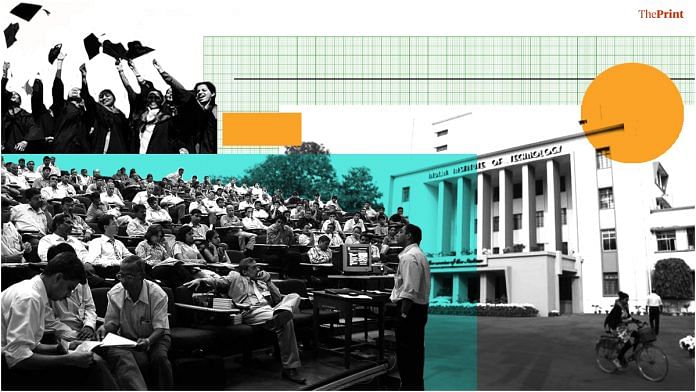IIT-Delhi and Bombay, and IISc Bangalore, along with most of India’s higher education institutions slipped in the 2021 QS World University Rankings released Wednesday. These include at least 10 Institutions of Eminence, which receive special focus of the Narendra Modi government. The number of Indian institutes in the top 1,000 dropped from 25 last year to 21.
ThePrint asks: IIT, IISC global rankings fall: How can India attract foreign students, faculty to improve?
Modi government needs to launch a ‘Study in India’ campaign to boost rankings
 V. Ramgopal Rao
V. Ramgopal Rao
Director, IIT Delhi
IIT Delhi needs to recruit a minimum of 60 international students and at least 80 international faculty to reach the global average. We also need to improve our faculty-student ratio. In these three parameters, we are losing out significantly.
The one parameter where we are doing well is in the research citation impact. The global average is 33 citations per faculty and for IIT Delhi it is more than 100 citations per faculty. We are doing three times better, but since citations just hold 20 per cent weightage in the overall QS ranking, we are getting pulled down.
Also, the international perception of IITs is lacking. Yes, we are known in the US, but we have also done a lot to make a reputation for ourselves in New Zealand, Australia or in South Asian countries like Japan. However, it’s not viable, economically or resource-wise, for individual IITs to go to these countries and market themselves.
The Narendra Modi government needs to launch a ‘Study in India’ campaign, similar to the ‘Incredible India’ tourism campaign. It can showcase IITs and the calibre of our institutions. An educational campaign is perhaps the best way to boost the rankings of all our higher education universities in one clean shot.
QS ranking metrics can be quite arbitrary and unscientific
 B Ananthanarayan
B Ananthanarayan
Professor, Centre for High Energy Physics, IISc
A worldwide catchment area for talent would definitely help the academic quality of Universities and institutions in India. This means making studying in India a pleasure, and not be a torture for students who have to line up at the Foreigners Regional Registration Office and local police stations for their living permits. Similarly, having international standard living quarters for students (University of Hyderabad has an outstanding International House, IISc has the Centenary Visitors Hostel), proper accreditation of courses, providing good cultural exchange possibilities could attract good students.
To attract foreign faculty, institutions need to foster a good working environment, with relatively little red-tape, good start-up grants, ease of handling students, providing international standard teaching assistants, a competitive salary, and generous vacation, coupled with good quality housing.
With regard to the QS rankings, sometimes their metrics can be quite arbitrary and unscientific. For instance, merely having one Nobel laureate could push an institution’s ranking up by several places. Such ranking schemes are so bizarre as to place newbies among the IITs higher than some of the most accomplished ones which have over half-a-century of contribution to the country and to the world. Just as citation Olympics have been forced to be recalibrated, in that several places could be gained by having faculty members in gigantic collaborations with thousands of authors and thereby garnering hundreds of thousands of citations, a new era of sensible ranking Olympics is also required.
Things will improve if institutions are allowed to be more flexible by regulators
 Dinesh Singh
Dinesh Singh
Former VC, University of Delhi
A student will travel far to study only if they get real value for money. This value is generally perceived to be in terms of the academic strength and relevance of the learning programmes offered.
If we glance at the degree programmes that the IITs or IISc offer, there is nothing that the student cannot find in their own country, particularly if they are from a western nation or even China. For instance, when I look at the offerings of the Imperial College of Science, Technology and Medicine in the area of mathematics, the number and variety of degree programmes is staggering. Altogether the mathematics department offers 8 distinct degrees with a fair amount of flexibility. This allows the student to seek over time, a specialisation that is in keeping with his or her needs and aspirations. The other disadvantage that the student finds is in the pedagogy in most Indian institutions that is mostly based on rote learning or bland lecturing. Just look at the innumerable complaints posted by IIT students on the internet about the dull nature of their pedagogical experiences.
If Indian institutions were to be allowed to be a bit more innovative and flexible by our venerable regulatory authorities, things will improve. We experienced this with much pleasure when students from Europe began to enroll for the BTech Humanities programme at Delhi University under the Design Your Degree concept that we ran at the Innovation Centre. Students from universities also took part in our College on Wheels programme–The Gyanodaya Express. Unfortunately these programmes were killed by the UGC.
Accommodating foreign students at IISc or IITs without reducing domestic intake difficult
Prithvi Datta Chandra Shobhi
Political commentator and teaches History and Humanities, Krea University
Securing admissions to the top IITs and IISc, particularly to the more prestigious academic programmes, is perhaps tougher than getting into Ivy League institutions. Even though in recent decades there has been a proliferation of IITs along with IIMs, AIIMS campuses and also new central universities across India, the intense competition for places at the top IITs hasn’t come down. Given this reality, it will not be easy to accommodate foreign students at IISc or IITs, without reducing the intake of Indian students. If these institutions are expanded that has to be done without compromising either faculty quality or infrastructure standards. That is easier said than done. Moreover, the institutions under consideration here are all in big cities, where expansion of physical facilities will be very challenging.
Would then attracting foreign faculty help? Chinese universities have tried this strategy to improve the quality of their education. But then salaries, research grants and other facilities, especially housing, necessary to attract world-class faculty will be prohibitively expensive. The Rs. 1,000 crore grant that the Narendra Modi government has promised to each of the ten public Institutions of Eminence is peanuts when compared to the annual budget of top universities, which runs into tens of thousands of crores. In addition to this, both foreign students and faculty will expect efficient handling of visa procedures; partnerships with other top universities and also with the industry; and counseling as well as placement services. Not all the Indian institutions have these capabilities now.
Also read: Can schools & students be trusted with Covid norms or should classes begin as curve flattens?
By Pia Krishnankutty, journalist at ThePrint




What is the ratings of Anil Ambani Institute of Aerospace
Why would anybody in their senses want to study in India’s IITs and IISc or any other Indian university when foreign students have better options in their own countries or elsewhere. None of India’s hallowed institutes have done anything worthwhile in their decades of existence. At best they select excellent manpower for supply to richer countries, at the cost of the Indian taxpayer. In the last so many decades not a single discovery, invention or creative idea has emerged from these institutions if eminence, where even academics are more interested in bureaucratese then any pioneering academic work.
Better salaries for faculty, high enough to attract some talented people from abroad. More students from SAARC countries, not necessarily to boost rankings, although that may be a welcome result, but as a conscious foreign policy choice. Our son’s tuition fee at IIM A was fifty thousand rupees per month, ten years ago, IITs may be comparable, so many should not be a constraint. This may well be a subjective assessment but my feeling is that IITs – especially the older ones – are very well regarded globally. Read today that 12% of people working on Artificial Intelligence in the US are from these institutions.